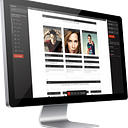Apps — from desktop to the web
or… what desktop has to offer to the web
We have all noticed that apps started to shift from desktop to the web. The web is now at its peak. It is advancing quite fast, and there is a high interest into it. A great community backs it up reaching to a point when apps are made possible. But it is much more than that. You rarely see software that looks good. Well most web apps are well designed. This means aesthetics, optimized user experience and nice graphics makes them more appealing to the users eye.
I personally love good design. I would use a piece of software that looks good, with basic functionality over one that has even more options but looks like it has been designed by a developer.
I know… browsers are software also. The web is limited to the browser, and the software is limited to the OS. Although, Chrome is trying to break those boundaries. Web apps may no longer be trapped inside a browser.
But still, I think there are a few things that web apps should have inherited from their desktop ancestors.
Splash screens
I would prefer a splash screen with a logo, loading status and a tip or two on how to use the app instead of a blank screen. All the resources can be loaded afterwards.
.wait { cursor: wait; }
We can’t ignore that spinning icon beside our cursor that is screaming that the computer is ‘thinking’. Whenever we make an action that can take a while, like loading some resources or ajax calls we can add a class to our body tag to point out ‘hey this may take a while…’, instead of masking or disabling everything out.
Shortcuts
I know, there are places where shortcuts can be used, github for instance. This is a call to the UX-persons out there… they should consider adding more tips on how mouse actions can be replaced with keyboard shortcuts. The title attribute of an anchor tag can be the action description followed by the key-combo. No harm to the user if you do that. They will decide in the end, if using their mouse and keyboard improves their productivity…
History / Retry / Undo
You can always see prompts inside apps that asks you: ‘Are you sure you want to do that?’. Nobody wants to be asked that, even if he clicked that action by mistake. Instead adding an undo button can spare him from reading the same prompt over and over again.
The use clicks button, the ajax call attached to that button fails for God knows what reason… What do you do? Just tell him that something went wrong? A retry button, even a timer to automatically retry that action sound like a nice idea.
If you find a way to register all of the user actions into a history, and provide him access to it I do believe the user would highly appreciate it. Photoshop does it and I love it.
Disabling options
I've seen some web interfaces that hide buttons that should be disabled instead, something most of the desktop apps don’t do. This is what happens when UX designers over-engineer stuff (as if they can do that). Hiding options will only confuse the user. Disabling an options by graying it out and adding a mouse-over tool tip with the reason will keep the UI consistent. Think of it as HAL9000 with it’s epic “I’m sorry Dave, I’m afraid I can’t do that”. You don’t see that in software since they don’t care about the user experience that much.
Actions that run in the background
The cool thing about web-sockets is that you can get live updates from the server. This means that you can allow users to make actions that take some time, and let them continue using the app, while you run their actions. You can notify them when their tasks are completed. This can be useful when you are giving the user the options of batch edit or syncing more things with the server.
User Interface
I've noticed that design-wise some software apps try to raise the bar a little. I really enjoy the every day software I use, like Adobe Photoshop, Mirillis Splash and Sublime. They all have nice, easy to use and customize-able interfaces. Most of the web apps that were designed, not those who use out of the box frameworks like Bootstrapp or jQueryUI, best any software app by far, but they are lacking a way for the user to feel like home. Customizing the look and feel is a very rare option that I've seen on some websites (twitter and gmail), but very limiting. Adobe Photoshop have those UI presets that you can use to increase your productivity which I find useful enough, but they even go further and let you create your own. We live in an era when the user generates content, we should let them be creative also, but not too much… A very cool feature of some desktop apps interfaces is the ‘distraction free’ mode. I find it very relaxing and you can focus on a particular task. Github has this option, although I don’t use it as much as I would like, also even slicker, Medium has it by default when posting.
So yeah… this concludes some of the features I think web apps can lend from the desktop ones, or use them within a better extend. I do know the web and desktop are two different environments, but by merging some of the behavior the user is already used to, from the desktop one, will benefit the experience and the learning curve for using the your web-app.
Comments, recommendations, tweet and re-tweets are always welcomed.

